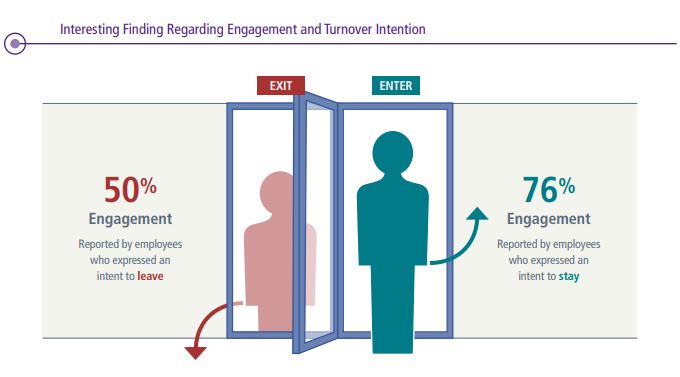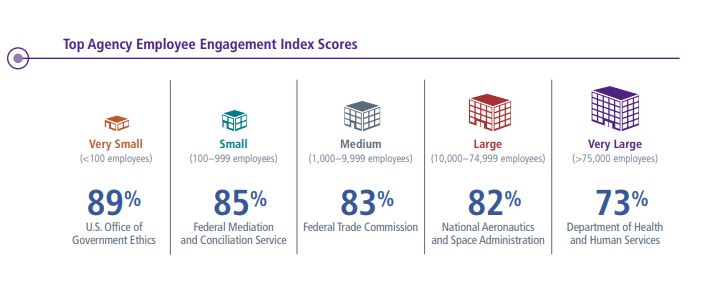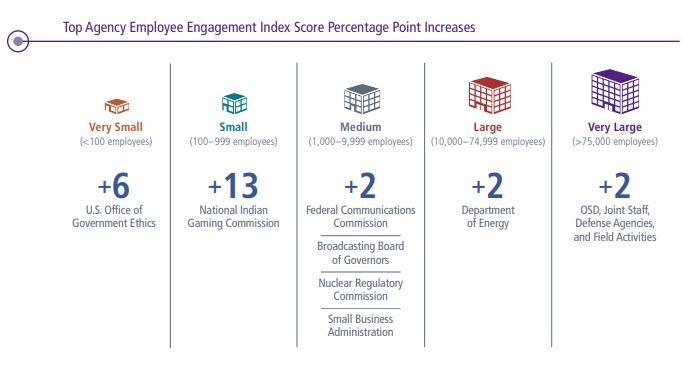

Employee engagement is up 1 percent from the previous year across the federal workforce, according to the results of the 2018 Federal Employee Viewpoint Survey from...
Best listening experience is on Chrome, Firefox or Safari. Subscribe to Federal Drive’s daily audio interviews on Apple Podcasts or PodcastOne.
Employee engagement in the federal workforce ticked up again slightly for the fifth consecutive year, according to the results of the 2018 Federal Employee Viewpoint Survey (FEVS).
Overall employee engagement reached 68 percent in 2018, a 1 percent bump over last year’s score of 67 percent. But like previous years, federal employees continued to show some dissatisfaction with their leaders, and few believe their colleagues are properly rewarded for good performance or held accountable for sub-standard work.
The survey results, which the Office of Personnel Management released Thursday afternoon, are designed to take the pulse of how federal employees are feeling about their jobs, workplaces and their agency’s leadership.
Individual agencies have been releasing their own results in recent weeks. The Veterans Affairs Department for the first time administered its own engagement survey but used only some of the same FEVS questions.
Margaret Weichert, who serves as both OPM acting director and the Office of Management and Budget’s deputy director for management, praised the federal workforce’s apparent enthusiasm for their agencies’ missions — 90 percent said they believe their work is important — but sees room for improvement in other areas.
“Unfortunately, our people also continue to feel that the federal government fails to fully align with merit system principles when measuring performance against rewards; only 26 percent of our people believe pay raises depend on positive performance,” she said in a statement. “Although the five-year trend for FEVS responses is moving in a positive direction, we cannot stop here and must continue to engage in dialogue with our workforce on how to enhance employee engagement.”
Roughly 25 percent of federal employees said pay raises depend on performance back in 2017.
The Trump administration has used this data point to fuel its push for more performance-based pay and rewards over an annual, across-the-board raise.
But dissatisfaction in pay for performance is just one of the familiar storylines in this year’s results.
Just 32 percent of federal employees said they believe their agencies take steps to deal with a poor performer who can’t or won’t improve, up slightly from last year’s score of 31 percent.
About 37 percent of the workforce said promotions in their work unit are based on merit, while 38 percent said their agencies recognize differences in performance in meaningful ways.
And 41 percent of the federal workforce said they believe the survey results will be used to make their agencies better places to work, down from 42 percent during the previous year.
Roughly 44 percent said senior leaders generate high levels of motivation and commitment, up from last year’s score of 43 percent.
And perhaps unsurprisingly, OPM found a correlation between engagement and an employee’s propensity to stay in government. Employees who expressed they intended to stay are generally more engaged than their colleagues who are eyeing the door.
“We take seriously our responsibility to make data-driven decisions that result in long-term success,” Weichert said. “We will look at underlying causes behind employee perceptions in order to replicate those that lead to positive responses and reshape the issues behind the negative observations.”

OPM issued the FEVS for the first time this year as a census, meaning all federal employees received the survey and had the option of taking it.
A total of 598,003 federal employees, 40.6 percent of the workforce, participated. Though more employees overall responded to the 2018 survey than last year, 2017’s response rate topped out at 46 percent.
Response rates for the FEVS have been steadily declining since 2015, when exactly half of the workforce participated in the survey, according to OPM.
Agencies generally see higher response rates as an indication that their employees take the survey seriously — and believe that their leaders will use the results to make noticeable changes at the workplace.
Roughly 57 percent of the Health and Human Services Department, for example, took this year’s survey, the highest response rate among very large agencies. HHS also has the highest employee engagement of any other agency of its size. About 73 percent of HHS employees reported positive engagement, according to OPM, up from last year’s 72 point score.

OPM’s governmentwide report doesn’t show ratings for all agencies, but it does point to several agencies who made improvements over the previous year.
NASA again is at the top among agencies of its size with an 82 percent engagement score.
Many agencies made small improvements over last year. The Office of the Secretary of Defense and other defense agencies improved by two points in 2018, the largest improvement of any very large agency.
The Energy Department also saw a two-point boost, while the Federal Communications Commission, Broadcasting Board of Governors, Nuclear Regulatory Commission and Small Business Administration each improved by two points and achieved a four-way tie among medium agencies.
 The smaller agencies, however, saw the highest increases over the previous year, with the National Indian Gaming Commission achieving a 13 percent boost and the Office of Government Ethics improving by 6 percent.
The smaller agencies, however, saw the highest increases over the previous year, with the National Indian Gaming Commission achieving a 13 percent boost and the Office of Government Ethics improving by 6 percent.
Copyright © 2025 Federal News Network. All rights reserved. This website is not intended for users located within the European Economic Area.
Nicole Ogrysko is a reporter for Federal News Network focusing on the federal workforce and federal pay and benefits.
Follow @nogryskoWFED

